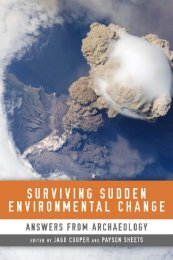Utatlan: The Constituted Community of the K'iche Maya of Q'umarkaj
Utatlan: The Constituted Community of the K'iche Maya of Q'umarkaj
Utatlan: The Constituted Community of the K'iche Maya of Q'umarkaj
Create successful ePaper yourself
Turn your PDF publications into a flip-book with our unique Google optimized e-Paper software.
<strong>The</strong> Greater Utatlán Project<br />
laid <strong>the</strong> groundwork for Brown’s later systematic survey <strong>of</strong> <strong>the</strong> Quiche Basin and<br />
identified <strong>the</strong> potential early K’iche’ centers for more intensive excavation.<br />
This volume reports on excavations undertaken to explore <strong>the</strong> Greater Utatlán<br />
residence zone peripheral to <strong>the</strong> center <strong>of</strong> Q’umarkaj, which might be considered an<br />
integral part <strong>of</strong> a unified community associated with and supportive <strong>of</strong> <strong>the</strong> political<br />
and religious center. Wallace (1977) and Carmack (1981) envisioned Greater<br />
Utatlán centered on Q’umarkaj, where <strong>the</strong> four principal lineages resided (Carmack<br />
1981: 162). <strong>The</strong> description by Wallace is concise and clear:<br />
<strong>The</strong> total contiguous occupation <strong>of</strong> Greater Utatlán, ignoring <strong>the</strong> barrancas, can<br />
be seen as a settlement type consisting <strong>of</strong> a fortified central area <strong>of</strong> many civic<br />
and religious structures along with elite residences, totaling about one quarter sq.<br />
km. This elite center is surrounded by a larger area <strong>of</strong> dense occupation <strong>of</strong> more<br />
modest structures, well built but not matching those <strong>of</strong> <strong>the</strong> elite centers in size or<br />
in specialized ritual-administration functions. <strong>The</strong> total area <strong>of</strong> dense, continuous<br />
occupation approaches 2 sq. km. Adding in <strong>the</strong> peripheral areas <strong>of</strong> less dense<br />
and-or discontinuous surface refuse, including that which occurs on <strong>the</strong> edge <strong>of</strong><br />
<strong>the</strong> La Estancia plateau to <strong>the</strong> west, and also on some <strong>of</strong> <strong>the</strong> tongues <strong>of</strong> flat land<br />
separated from <strong>the</strong> more densely occupied suburbs, <strong>the</strong> total area may prove to<br />
be about 4 sq. km. (1977: 40)<br />
Potentially included in this zone are several o<strong>the</strong>r identifiable sites and <strong>the</strong> plateaus<br />
contiguous with <strong>the</strong>se sites (Map 1.2). South <strong>of</strong> Q’umarkaj, across a deep<br />
barranca, is Pismachi, an earlier K’iche’ political center. Following <strong>the</strong> establishment<br />
<strong>of</strong> Q’umarkaj, Pismachi was relinquished to <strong>the</strong> allied lineages <strong>of</strong> <strong>the</strong> Tamub’<br />
(Carmack 1981: 162). Across a barranca north <strong>of</strong> Q’umarkaj lies Chisalin, home<br />
<strong>of</strong> <strong>the</strong> allied Ilocab’ lineages (Carmack 1981: 163; Weeks 1980). Extending east<br />
from Q’umarkaj, along <strong>the</strong> adjoining plateau, were <strong>the</strong> sites <strong>of</strong> Resguardo (also<br />
known as Atalaya) and, fur<strong>the</strong>r east, Pakaman. Resguardo has <strong>the</strong> appearance <strong>of</strong><br />
a hilltop fortress guarding <strong>the</strong> entry to Q’umarkaj and is thought to be associated<br />
with <strong>the</strong> K’iche’ lineage <strong>of</strong> Nihaib’. It has two temples, one at each end <strong>of</strong> a<br />
plaza; a small ball court; and associated long structures; as well as some flanking<br />
structures on <strong>the</strong> terraced sides <strong>of</strong> <strong>the</strong> hill (Carmack 1981: fig. 8.7). Pakaman has<br />
a temple and a long structure, as well as nearby mounds, and is also considered<br />
an outpost guarding <strong>the</strong> approach to Q’umarkaj, possibly at one time garrisoned<br />
or occupied by Kaqchikel warrior allies <strong>of</strong> <strong>the</strong> K’iche’ (Carmack 1981: 245–248;<br />
Weeks 1975).<br />
It can be difficult to gauge area for irregularly configured land using topographic<br />
maps, but I have attempted to do so (Map 1.3) based on <strong>the</strong> proposed outlines<br />
in <strong>the</strong> map provided in <strong>the</strong> grant proposal for <strong>the</strong> archaeological work in <strong>the</strong><br />
Quiche Basin (Carmack and Wallace n.d.). <strong>The</strong>se boundaries were transferred to<br />
an enlargement <strong>of</strong> <strong>the</strong> topographic map <strong>of</strong> <strong>the</strong> area (Instituto Geográfico Nacional<br />
11





